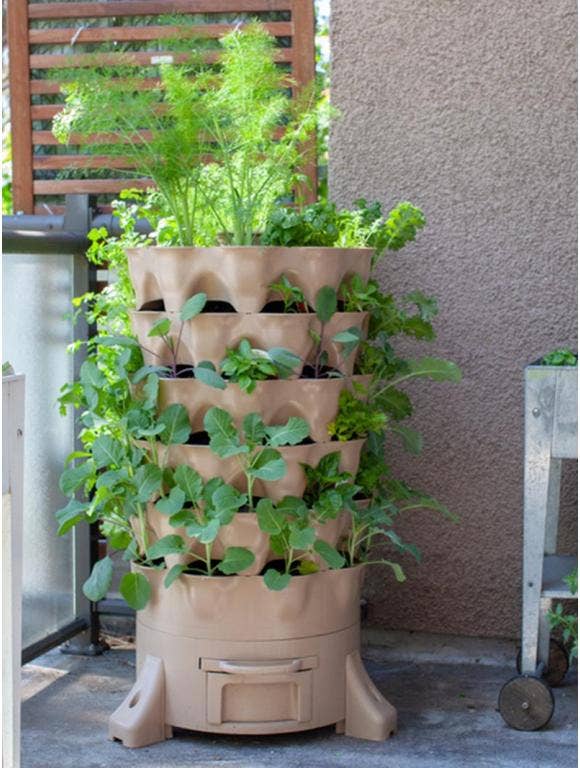
Densely populated cities have limited space for cultivating gardens. But despite the constraints, you can still live in a city and take advantage of one of these opportunities for exercising your green thumb.
What Is Urban Gardening?
Urban gardening is simply the process of growing plants within an urban environment. While some fortunate city dwellers have plots of land on which to garden, urban areas tend to be more concrete jungle than fertile farmland. Since much of the population lives in apartment buildings, high rises or other residences with limited outdoor space, urban gardening generally refers to small space gardening or semiprivate community gardens.
City gardens range from window boxes and a few pots on a windowsill to container gardens on a concrete patio or balcony. They can also include large rooftop gardens, alleyways, tiny backyards with a bit of soil and even small strip gardens between the sidewalk and the road.
People who want to garden will find ways to do so even in areas devoid of soil. Some guerilla gardeners armed with shovels and seeds plant illicit gardens in abandoned or disused public spaces. Vacant lots and highway medians can become farms, and dumpsters, even potholes, morph into gardens in the hands of these horticultural warriors.
Urban Farming
With the average carrot traveling over a thousand miles from farm to plate, urban farms are also cropping up in major cities. One of the largest — a 1-acre rooftop farm and 10,000-square-foot orchard, food forest and greenhouse — sits atop New York City's Javits Center.
Types of Urban Gardens
An urban garden can take a variety of shapes. What your garden looks like may depend on the amount of space you have or what you plan on growing.
Container Gardens
Containers conserve space, help control pests and make it easy to maintain soil quality. They can be new or repurposed from just about anything, including buckets, barrels and even old boots. Optimize space by hanging baskets and planting in elevated planters. Both are accessible and leave valuable floor space for stashing supplies and tools. A few large containers, rather than several small ones, can make a space seem larger or function as a focal point.
Lightweight pots are ideal if you're a renter, as they can be relocated. Placing heavier pots on caddies also works well for chasing the sun. Size limitations aside, you can grow pretty much everything in containers that you can in the ground, as long as you choose container-friendly varieties. Some of the easiest vegetables to grow in containers include tomatoes, peppers, potatoes and eggplant. Other good choices are lettuce, onions, squash, radishes, herbs and dwarf fruit trees, like the evergreen dwarf citrus 'Bearss Lime'.
Container Garden Considerations
• Growing in containers can cause plants to dry out faster, so they need more frequent watering. Take the guesswork out of it and avoid overwatering with a self-watering planter.
• Drainage is essential. Make sure containers have adequate drainage holes.
• Always use good quality potting mix — not garden soil — to help maintain moisture.
• Match the container to the plant. Shallow-rooted plants under a foot tall need at least 6 inches of soil, and deeper-rooted plants require at least 1 foot of soil.
• Combine plants with the same growing requirements — either all sun or all shade — to prevent a faster-growing variety from overtaking its companion.
Vertical Gardens and Green Walls
Functional and decorative green walls carpet the facades of skyscrapers and small apartment patio walls alike. Vertical gardens climb up otherwise unused surfaces to grow herbs, vegetables, ornamentals or a combination of all three. Living walls cover bland slabs both indoors and out with lush foliage that provides natural insulation to reduce energy consumption.
Whether freestanding in containers with supports or mounted on flat surfaces, the structures should be appropriate for the plant type and durable enough to handle the weight of the plant and soil. You can yield a sizable harvest in pocket planters, repurposed pallets, or assemblages of pots on shelves, on the steps of a ladder leaning against the wall and in hanging baskets. Vertical gardens can also double as privacy screening or can block unsightly views.
Rooftop Gardens and Green Roofs
Rooftop gardens have become the prized amenity of new high-rise urban residential buildings. Massive roofs incorporate lawns, grilling and dining areas with fire pits, and sprawling edible gardens encompassing several thousand square feet.
Indoor Gardens
What is urban gardening if you don't have any outdoor space? You can still grow a good amount of food indoors. An internet search will turn up a myriad of choices for countertop smart gardens and containers with integrated irrigation and lighting systems that make indoor gardening nearly foolproof. With adequate sunlight or grow lights, you can grow many of the same small plants as your neighbors with outdoor gardens.
Community Gardens
Many city dwellers, even some with garden space, choose to join community gardens for the many benefits and opportunities they provide. Shared gardens offer social connection, exercise, access to healthy food at a reduced cost and hands-on horticultural education for gardeners of all ages. Community gardens vary from family plots, school gardens and larger urban farms to tiny pollinator pocket parks. They preserve open space, beautify neighborhoods and bring people together to encourage friendship, cooperation and understanding among diverse groups.
Planning an Urban Garden
To flourish, an urban garden requires the same basic needs as any garden: light, good soil, adequate air circulation, water and nutrients. Start assessing your site location and conditions, such as size, exposure to light and wind, access to water and what thrives in your particular growing zone.
If you live in an apartment, check with your homeowner association or landlord about any restrictions or limitations. Find out how much weight a rooftop or balcony can support and whether the roof or floor surface is waterproof. Chances are a concrete planter filled with soil will be too heavy for that 20th-floor balcony, so lightweight fiberglass might be a better choice. On tall buildings, balconies or terraces may be subject to extreme wind conditions, requiring adaptable design solutions.
Set Your Garden Goals
Decide what kind of outdoor space and garden you want. Is it for lounging and relaxation, entertaining, greening the space with foliage, growing food or a combination of these? If planting an edible garden, decide what you like to eat. Then, ask yourself how much time you have or are willing to spend cultivating the garden.
Design for Your Space
Since space is at a premium in most metropolitan areas, you need to make every inch count. Multipurpose furnishings can help conserve space. If you have a small bit of earth to till, raised beds and keyhole gardens can produce generous harvests in a small amount of space.
Know Your Growing Conditions
Plants require either full sun, partial sun, partial shade or full shade. The direction your garden faces determines how much sun it gets. South-facing yards get the most sun, while north-facing sites get the least.
Full sun means at least six to eight hours of direct sunlight. Southern-facing patios usually get more than eight hours of sun per day, great for sun-loving plants like rosemary, deeply fragrant 'Munstead' lavender and hardy, disease-resistant 'Red Drift' roses. Western-facing gardens receive about six hours of sun where most full-sun plants can thrive.
Both partial sun and partial shade usually mean four to six hours of sun or shade each day, ideally morning and early afternoon sun. Eastern-facing patios get several hours of cooler, bright, direct sun and part shade.
Full shade means bright light with little or no direct sun — sometimes called dappled light. Northern-facing spaces get fewer than four hours of sun, which is good for full-shade perennials like 'Forever Purple' heuchera (aka coral bells), whose glossy purple leaves and short spikes of pink flowers mix nicely with hostas, primrose and bleeding heart. Consider tall grasses, too, like golden variegated 'Aureola' hakonechloa that will cascade nicely over the side of a container.
Urban Garden Pests and Disease
Potted plants tend to have fewer problems with pests and disease, but they're not free from them.
Purchase only healthy plants and wash them thoroughly before planting them in clean containers. Use a fresh growing medium, and don't reuse potting soil. Remove infested and diseased plants, and be sure to wash your hands and garden tools after handling them.
Growing plants in optimal conditions with adequate sunlight, nutrients and water can produce healthy plants that will be more resistant to pests and disease.
Your Urban Garden Essentials
In addition to sunlight, quality potting soil and access to water, you'll want some slow-release fertilizer along with containers suited to your plant choices. And if growing vertically, you'll need structures and supports. Start with a few basic tools and supplies, including pruning shears, a handheld rake and spade, gardening gloves, a lightweight expandable hose, a watering can and a spray bottle. Invest in a small potting table if you have room for one.
With a little planning, you'll find less is sometimes more and that you can grow a lot in an asphalt jungle.
For more information on small space gardening, check out Burpee's tips for starting a patio garden.



